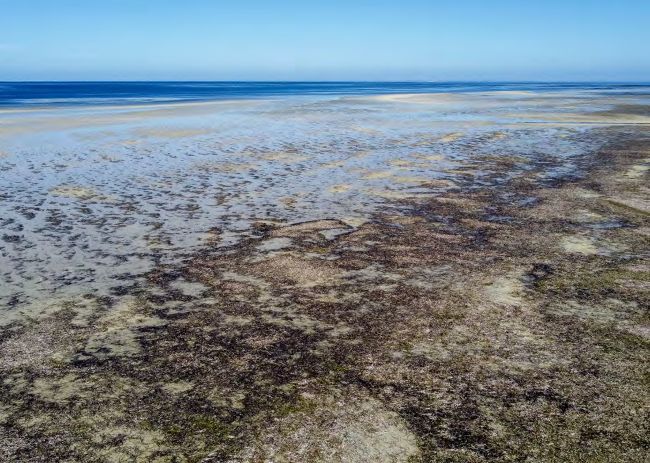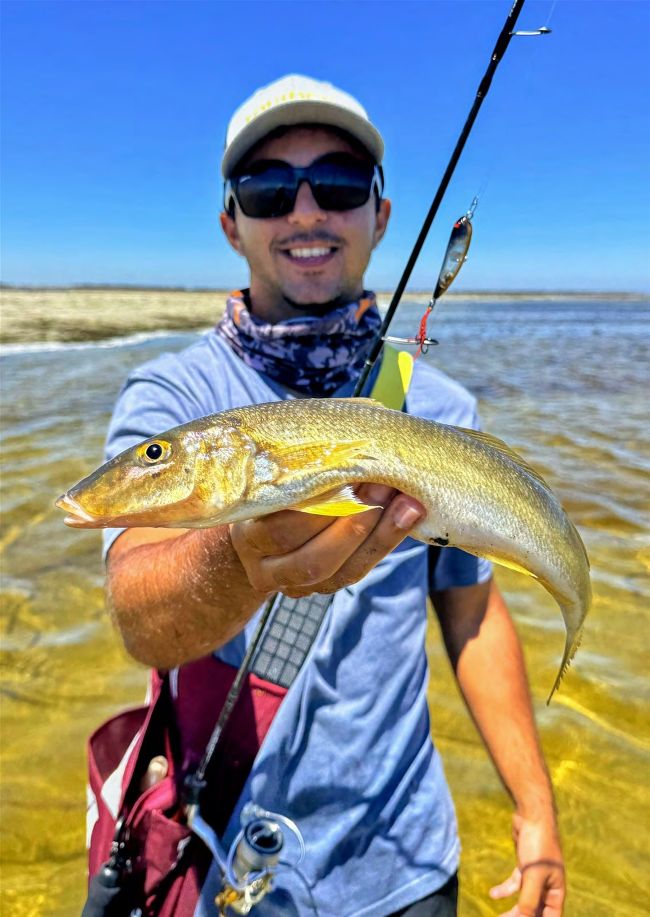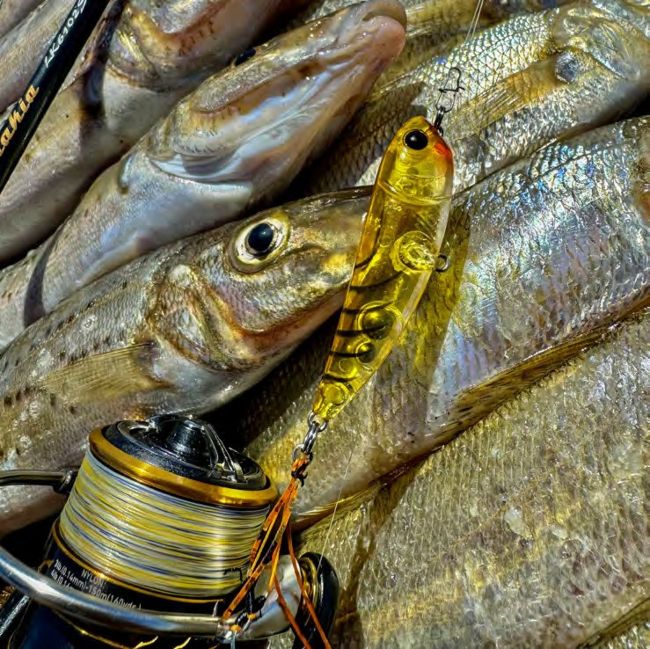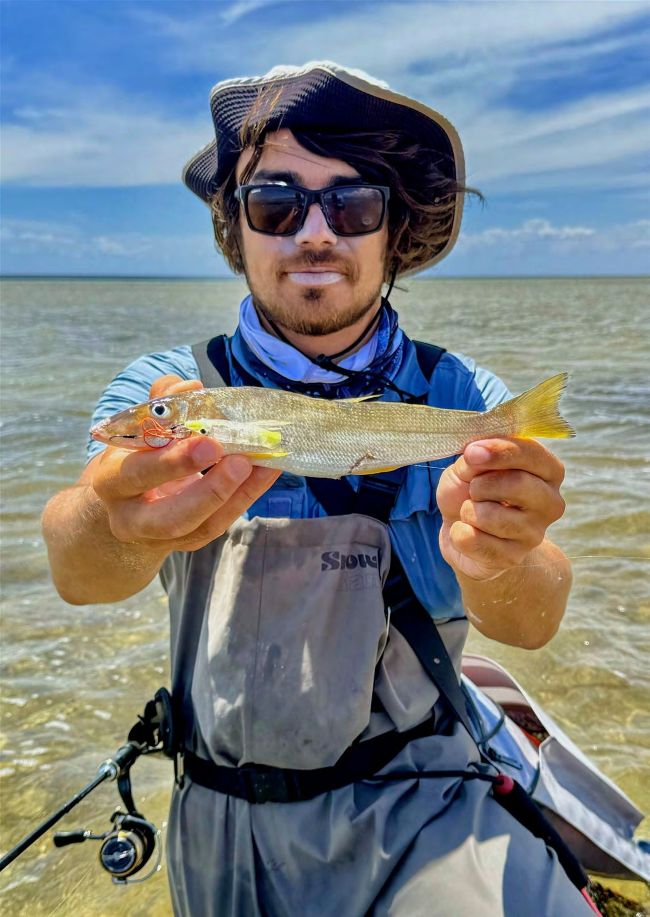THE GOOD OIL ON YELLOWFIN
Jordan Saliba and Oliver Wood Get together to provide the most comprehensive guide to catching yellowfin whiting we have ever run.
Yellowfin whiting is an exciting target species with plenty of attitude that lures in anglers across the state. These versatile critters can be targeted using a variety of methods, such as bait and various types of lures. Before delving into what an awesome animal these fish are, we shall introduce ourselves and the topics of this article.
Our names are Jordan and Oli and we have been fishing the flats for over 15 years between us. Over that time we have fallen in love with this style of fishing, making countless memories along the way. The highs, the lows, the long days, the sore feet and the intense, heart-pounding moments that the flats produce, year in and year out, draw us back every summer as we eagerly anticipate each mission. In this article we will touch on why we love flats fishing, some flats fishing essentials and, most importantly, how and when to locate these often elusive beasts.
SELECTING THE RIGHT GEAR
When it comes to chasing silver fins off the beach, being mindful that your gear selection can make a world of difference in your conversion and hook-up rate. As someone who has spent quite some time trying different rod lengths and reel sizes, I have come to realise what best works for me. In this section I am going to walk you through my recommendations for both casting bait and top-water lures.
RODS
When bait fishing off the flats, the length of your rod is your secret weapon that gives you the edge over most anglers. Oli and I both agree that opting for a rod around 7-9 feet strikes the perfect balance for this style of fishing. A longer rod facilitates longer casts, which is crucial when trying to reach those gutters and sand banks which yellowfin love to sit in. A longer rod and stiffer tip also give you that leverage and control when they do their famous little sprints that follow a successful hook-up. I personally have found my 8’3” rod to be extremely efficient in ensuring a high hookup rate and confidence when fighting these fish.

Now, which lure should I try first?
In the exhilarating realm of top-water fishing for these gold bars, the right rod length is key to orchestrating the perfect action of your lure. Through trial and error I discovered that a shorter rod, typically 6-7ft, is the underachiever in this style of fishing. A short, more compact rod allows precise targeted casts, ensuring the lure dances with intent to entice that addictive thrill of the chase from these fish.
REELS
Now that you have a better idea of what rod you need, achieving the perfect harmony in pairing it with its ideal partner in crime is vital. I have used a 1000, 2000 and 2500 reel for bait and lure fishing, and I personally fell in love with the idea of an ultra-light reel for both applications. My rod is quite light, so a little 1000 reel has been the best decision I’ve made. This allows me to throw countless casts all day and making those battles a whole heap of fun when all you can do is sit back and listen to that line peel away!
LINE
Last step to completing the perfect harmony is pairing your reel with the ideal line. For the pursuit of these coastal gems, an ideal braid strength falls within 4-8 pounds. Not only does it allow ultra-smooth casting, but it also offers a delicate balance, providing the strength needed to handle their famous runs from afar. I tie 4-6lb mono leader to the end to enhance my stealth, resulting in more fish!
BEST HOOKS, LINE, AND SINKERS FOR MAKING RIGS
I used to make a trip to my local BCF and buy those “whiting rigs” which, at the time, looked OK. However, after a while I noticed the line would become weak and the hooks would only stay sharp for a couple of sessions. This is when I took an interest in learning how to make my own rigs. So, over a couple coffees at Oli’s house, he taught me the craft of making all the knots and important things to know when crafting the perfect rig. Now for me, sitting down and listening to music while sitting there for hours crafting the rigs is something I do as a mindful exercise.
HOOKS
I have used all three styles — long shank, circle, and octopus hooks — and I found one clear winner, the octopus hook. Most quality brands create a dynamite octopus hook, but if we’re being ultra-specific in this case, I use a size 2/0 Black Magic, which I now swear by. The shape of an octopus hook gives great versatility, higher hook-up rates and creates an ease when it comes to presenting bait.
LINE
What I love about creating your own rigs is that you can choose the line strength and determine what is best for the target species. In the case of these gold bars, I find 6-8lb gives the perfect stealth, yet suitable strength when fighting those big 35cm-plus models.
MY FAVOURITE RIG
My rig of choice is the paternoster with two dropper hooks, followed to a 1/2oz sinker. I run just over an arm length of leader, having one hook sitting halfway up the line and the other just below the sinker, which sits on the bottom. This is effective for these fish who love a bottom feed! Plus, fishing off sand you can’t get snagged, so having one hook below your sinker is risk free and has paid dividends for me in some recent missions.
CONDITIONS AND WEATHER
If you know yellowfin whiting, you will understand how important the weather and water conditions are. Get them right and success will sure follow, however, get them wrong and you will struggle to find fish. Tides are one of the most important factors when targeting yellowfin. Acting like blood to the human body, tides allow all the sand flats’ inhabitants to hunt for their prey over a large or small area.
At high tide the fishable area on the flats can often treble in size, spreading our target species out over an extremely large area and making them extremely elusive. However, at low tide the flats ecosystem is considerably smaller, condensing the predatory fish species into a much smaller target area and, thus, making life much easier. We have found both the incoming and outgoing tides to be productive, with no real consistency as to which fishes better. We usually start our yellowfin missions around an hour and a half before dead low tide and fish through the incoming tide. Having tide movement is critical for your success, with the age old saying ‘No run, no fun’ having profound truth on the flats.
During the lead up to the yellowfin season, flats fishers eagerly anticipate the increase in water temperature that triggers the fish to gorge on the large quantities of crustaceans, bivalves, and worms. All this eating ensures good condition for a successful breeding season for these fish. I have found the magical water temperature to trigger the start of the feeding frenzy to be about 22 degrees, with more substantial feeding occurring when the water hits around 24 degrees. Consequently, the best time of year to break out the waders and flats gear can be as early as October through to as late as March, with peak catches coming through December to February.
Turning our attention airborne, the weather can also heavily influence whether these awesome fish bite or take flight. The sun is a flats fisho’s best friend, making it much easier to spot and sight cast schools of yellowfin whiting. Not only do sunny conditions help with spotting fish, but also seem to make the whiting lose all inhibitions, sending them often into a feeding frenzy. If you are considering catching these fish on lures, the sun is essential, but bait fishermen can enjoy catching them when there are some clouds in the sky.

Survey the flats at low tide to suss out the best fishing areas
Wind can either assist or hinder your attempts, depending on direction and ferocity. Offshore winds around 10-20 kph or 5-10 knots are our absolute favourite, with fishing becoming difficult around the 35-40 kph mark. We have often found yellowfin to enjoy the glass taken off the surface of the , making the absolute ideal wind speed to be around 10-15kph.
It’s important to note that during late spring and early summer, the mid to late afternoon regularly brings out a powerful onshore ‘sea breeze’, making fishing extremely uncomfortable as the chop can increase out of nowhere. Recognising when to finish your session can be critical for your safety and enjoyment.
To catch yellowfin whiting I like to try to keep it as simple as possible. Recently, however, I have made the effort to record the moon phases in my flats fishing journal and have discovered that the moon does play a part in this form of fishing. My sessions for a couple of days after a full moon were quite slow and through some research, I had found that during full moon events, yellowfin whiting feed heavily throughout the day and night. This mass feeding causes the fish to be quite inactive in the first few days after the full moon. On the flip side, sessions leading into and on a full moon are usually my most productive.
READING THE ZONES
Yellowfin whiting are an extremely rewarding fish, and with some experience you will find they can be somewhat predictable in their movement and feeding patterns.
Like all their cousins, they are predominantly bottom feeding creatures, occasionally feeding on fleeing prawns and baitfish. They utilise their strong sense of smell and their keen eyesight to detect even the slightest of prey items.
A favourite prey item is the clicker — a small crustacean that burrows in softer, mud-like sandon-sand flats and in estuarine ecosystems. We have found in our most successful outings that we were able to quickly locate this softer sand that held plenty of prey items.
Yellowfin, like most fish species, can be quite lazy, making sure that they conserve their energy for the breeding season ahead. In conserving their energy they will cruise with the current up onto the flats and then off again. If you manage to find these gutters, mixed with the softer clicker beds, you will find plenty of feeding yellowfin in no time. It is also important to fish these gutters during tide movement. Positioning yourself on sand bars alongside these channels is a great way to find new schools of fish making their way up or off the flats.
Locating these areas can be easier said than done. I have found the best way is by knuckling down and spending plenty of time learning your desired location. The second-best way to grasp a sense of a particular spot is to get a birds’ eye view via Google Earth or Maps satellite view. This enables you to get a sense of the location before setting foot on the beach.
BEST BAITS
For these silver-scaled treasures, throwing out the right baits and presenting them is difference between getting a bag limit or half a dozen. These bottom feeders cannot resist the temptation of clickers, bloodworms, tube worms, prawns, cockles or even the fresh squid candle. If I had to choose my top three baits from one to three it would be bloodworms, clickers, then cockle.

That’s why they call them ‘gold bars’!
BAITING STRATEGIES
Presenting baits with the right finesse to mimic the whiting’s preferred prey is the formula of success. A very popular bait choice for yellowfin whiting are bloodworms, so I will use that as an example.
For bloodworms I cut about 5cm of worm and thread it through the hook twice, leaving 3-4cm of the worm dangling while keeping solid hook exposure. The concept of leaving your bait dangling mimics more movement, which triggers these very curious fish by nature. My best advice would be taking great pride in presenting your bait and experimenting new techniques.
LURES VERSUS BAIT
The timeless debate of whether using lures or bait for yellowfin whiting is more effective is one that will never end. But what we will talk about are the pros and cons for both these strategies. I will go into my opinion about using bait and Oli will dive into the advantages and disadvantages of using lures.
PROS AND CONS OF USING BAIT
Opting for bait when targeting yellowfin whiting presents a classic approach, which has stood the test of time. The advantages of using bait are its natural scent and presentation which bring the fish to you. It’s user friendly and tends to be more accessible for anglers of all skill levels.
In relation to it ‘attracting’ the fish to you, there is always the factor that smaller and less desirable species will capitalise on the free feed. During warmer months it is almost impossible to have a session without bumping into some annoying little critters such as the toad fish (the hook snatcher!).
In my experience so far, if I were chasing my bag limit, I would definitely go down the path of using bait. If I’m trying to crack that elusive 40cm-plus fish and the thrill of the top-water bite, I would be bringing my box of lures with me!
PROS AND CONS OF USING LURES
Recently I have taken the step towards using top-water lures when targeting yellowfin whiting. These fish are absolutely thrilling to catch on surface lures, with the increased difficulty only adding to this enthralling form of fishing. The aggressive response that surface lures bring out of these attitudepacked pocket rockets is the reason why I highly recommend the experienced fishermen give it a crack.
With a massive market here in South Australia, many lure companies, both big and small, have made their variations on small, ‘walk the dog’ and popping lures to target a wide variety of target species, including yellowfin. I have found lures that are clear with prawn-like patterns to be my most successful selection.
RECORDING YOUR SESSIONS INTO A LOGBOOK
A logbook or journal is the best way to keep tabs on patterns, bite times and the best locations to fish. I have kept a diligent fishing journal in almost all my fishing ventures and dedicate my success to utilising this form of note taking and reflection. In my journal I write what weather and water conditions were experienced, when I landed fish in quick succession, what areas I fished, the methods I used, and the rough size of the fish landed. I also add in a short paragraph of how the session went and what I could do to improve in my next adventure.
Journaling is a simple, yet effective way of gaining a vast amount of valuable information over your fishing sessions and I couldn’t recommend it more for both new and experienced anglers. It is also important to be patient and willing to fail to experience success. The phrase ‘Rome wasn’t built in a day’ is an important one to consider when learning any new form of fishing. The best way to experience success is to get out there and fish!
FISHING SOLO OR WITH A BUDDY
Fishing with a buddy can be a fantastic way of sharing the experience of flats fishing and, if done well, I believe it is more rewarding than fishing alone.
Having two sets of eyes locating schools of fish and potential casting spots is certainly better than one, but be mindful not to step on each other’s toes by creating unnecessary tangles and extra stress. Also be mindful to not spook each other’s fish and communicate with each other, which will ensure happy fishing and tonnes more success for the both of you.
If you are more of a lone wolf, there is still plenty of awesome fishing to be had on the flats. I strongly recommend that if you are fishing alone, to bring your wits and a sharp eye to spot awesome fishing grounds. The more experienced anglers will spot fish with ease and know what areas hold fish, so if you are new and have an experienced fishing buddy, I highly suggest trying to tag along on a flats mission to learn on the go!
ESSENTIAL ACCESSORIES
When engaging in land-based flats fishing, go prepared! One of the best investments I have made so far is a good pair of aqua shoes, which has kept my feet safe from sharp rock, crabs and any other dangerous objects or creatures. If you want to invest further, grab yourself a high-quality wading suit that adds comfort, safety, and storage on the water!
Having somewhere to store your fish is essential, and my Alvey wading bag has been the perfect solution to this problem. It has a nice deep pocket to store fish, a rod holder, and two other pockets which I use to store bait, lures, and other tackle.
One of the harshest parts of flats fishing is losing a fish right at your feet because you tried lifting it out the water and had it either shake the hooks or, even worse, you pulled the hook from its mouth. This is where my Berkley net, which is small and compact, comes into its own. Instead of worrying about losing that dream fish, you can very smoothly net it and keep it from escaping!
Something I wouldn’t fish without are my polarised Spotters sunglasses. Not only do they protect your eyes from sun glare, they enable you to spot these sand-coloured fish from afar.
Some other honourable mentions would be a sun-safe hat, neck gaiter, long sleeve shirt, high quality sunscreen and a waterproof phone case.
JORDAN AND OLI’S TREASURE HUNT!
Oli and I have been on many flats missions together and in this article, I am going to share a session with you which took place over a three-day camping trip on the Yorke Peninsula.

Top-water lures come in many sizes, colours and styles

An average fish hooked on a prawn imitation
It was a scorching hot day with not a breath of wind, as Oli and I cut through the glassy water in anticipation of securing a feed of yellowfin whiting. As we made our way towards the water, we had to pinch ourselves because it felt like we had just walked into a scenic postcard. Nothing will beat that moment of stepping your first foot onto the flats and getting that feeling the adventure has officially begun.
The method we selected was using bait (bloodworms), which we partnered with a paternoster rig using two dropper hooks and a light sinker. It was the beginning of an incoming tide, so our first mission was walking out to the deeper zones while the shallower areas were not yet fishable. Halfway to the weed line we spotted a nice sand bar, so we decided to have a quick cast to try our luck… fish on! Just like that, Oli had caught the first whiting of the day and it was no small one either!
Soon after that we ventured out to our desired zone, and I launched my rig into a nice deep gutter I had spotted with great hope of a legal fish. I hadn’t had any bites, but was willing to be patient, so I slowly reeled in my line a to kick up some sand along the bottom, hoping that would entice a fish to have bite. A little bit of patience and theorising resulted in my first legal fish, which was above legal size!
If we had learnt anything from our recent trips, it’s making sure you cast straight back into that same zone because they often school up together. Oli cast in front of the gutter while I went a little further right. After no more than five secondswe had got our first double hook-up for the day, which really put us on a high. Normally, after you catch a two or three fish from a school, they spook away, but it never hurts to have another cast. Fortunately, I think it was my lucky day, as I managed to convert three casts into three fish, all in the same gutter. What a way to start!
After both catching quite a few fish each, we decided to head back and have something to eat and continue our adventure later in the afternoon. Oli and I take great pride in storing our catches humanely and making sure the meat keeps its fabulous potential, so we got the fish into an ice slurry, filleting them later that day and placing straight into the portable freezer!
This was just the beginning of what was a trip Oli and I will remember forever. Warm campfires, good banter, lots of big fish and the chance to press the reset button and just relax were the main benefits.
If you are interested in seeing how all this trip unfolded, you can watch the full adventure on my YouTube channel https://www.youtube.com/channel/UCmoD-ZY2IQJHMMn1umtWwbw. I have also given the links to all three parts of the trip for you to enjoy! Oli also creates some awesome content, so I would highly recommend you go over to https://www.youtube.com/@olissquidding133 and check it out!
Part 1:
https://www.youtube.com/
watch?v=dfEqSms6_OI&t=1442s
Part 2:
https://www.youtube.com/
watch?v=-x2bqqJRDpw&t=239s
Part 3:
https://www.youtube.com/
watch?v=PdoH9ksIPkA&t=565s
In conclusion, we hope you’ve managed to learn a thing or two and got a better idea on how to target yellowfin whiting. Please make sure you respect laws and regulations around these fish and only take what you need to ensure a bright future for generations to come! We also hope you are enjoying the brand-new digital format of SA Angler, which we absolutely love! Brett and his team work countless hours behind the scenes to provide articles like these, so please show them your positive support moving forward! Until next time, tight lines fishos!